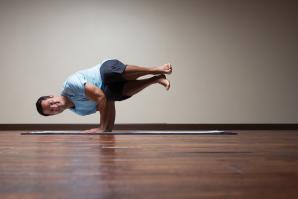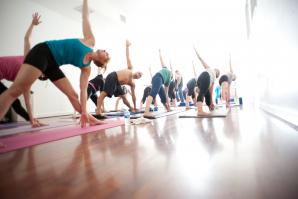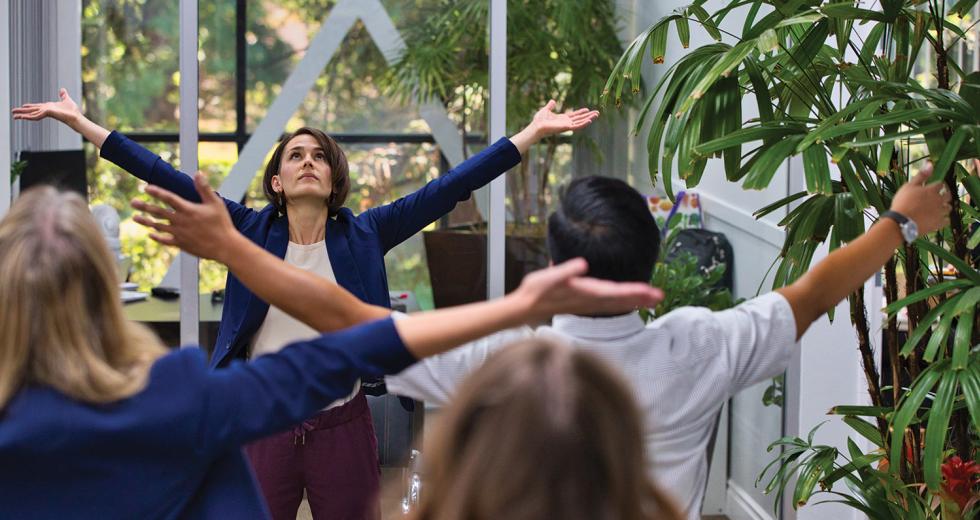He wanted something different. Something that stirred the heartstrings. So he suggested yoga. And not just any yoga, but stand-up paddleboard yoga, the kind where one could fall into the water. He persuaded the senior executives — mostly yoga virgins, all men in their 50s and 60s — to wake up before dawn, scrap their normal agenda and travel to a lake in Placerville. The air was crisp. They saw bald eagles, deer, fish. The executives paddled onto the lake, and they took deep breaths, led by a Spotted Dog Yoga instructor. “Everyone loved it,” says Walker, his voice full of triumph.
Welcome to the world of office yoga, a curious merger of yoga and commerce. It turns out that mindfulness can be lucrative. According to a 2016 survey from Yoga Journal, 36.7 million Americans practice yoga, a nearly 80 percent jump from 2012 (20.4 million), fueling a $16 billion industry. Entrepreneurial yogis are now branching out from the studio and into the offices, lobbies and conference rooms of corporate America.
Enthusiasts say workplace yoga is more than a fad — it’s a way to boost morale and curb anxiety. “Yoga gives employees a method of dealing with stress,” says Katie Clark, co-owner of Spotted Dog Yoga in Folsom. “When we teach to businesses, we teach things that they can do at the office, at their desk. Tools that are simple and easy.” Even #officeyoga is a thing, with Instagram showing an endless stream of lithe, blissful workers cheerfully stretching in their cubicles. Are chakras the new spreadsheets?
The Om Is Optional
I’ll cop to my own skepticism. To put it plainly, office yoga feels like a pain in the butt. There’s the hassle of changing clothes, dealing with sweat, the time it takes to shower. And who wants to do a Downward-Facing Dog in front of the boss? To address these kinds of concerns, and in a bit of savvy marketing, Sacramento-based yoga instructor Chandra Lovejoy teaches an in-the-office class through Lovejoy Office Yoga she describes as no-change, no-sweat. Sessions are only 30-60 minutes. They are held in a conference room. People can wear their normal work clothes — no mat required, and no awkward poses that highlight parts of one’s body that one does not wish to highlight.
“These are modified versions of classic yoga poses,” says Lovejoy. Imagine standing in front of your desk. Put both hands on the table, walk your legs back, keep walking back, stretch, and now you’re in a modified Downward-Facing Dog. Lovejoy says office workers can benefit from a pose like this, because our spines are compressed from all the desk sitting and laptop hunching. “These poses decompress the spine,” she says.
The yoga-at-work trend, like seemingly every workplace trend, first took off in Silicon Valley. In 2011, part-time yoga instructor Maryam Sharifzadeh had a single corporate client. She wondered if other companies wanted this. “I was like, ‘Hey, maybe this is a thing,’” she says now. She needed a name for the company, and decided on the easy-to-remember Office Yoga. What began as a side hustle now has 20 instructors in the Bay Area (Office Yoga is headquartered in San Francisco), another 15 instructors nationwide (Los Angeles, Chicago, Dallas, Austin and so on — and she plans to expand to Sacramento), and clients that include McKinsey & Company, Oracle and the Oakland A’s front-office staff.
Lovejoy started as an instructor at Office Yoga in San Francisco. She found the Bay Area to be saturated with workplace yoga. “In the Bay Area, it’s like, ‘Yeah, of course, you don’t have office yoga?’” She taught deep-pocket clients such as Google and AMAG. Two years ago, she moved to Sacramento, partly for the same reason many people move from the Bay Area (lower living costs), and partly to grow her own workplace yoga business in a less crowded space. Her clients now include property management firm Dick James & Associates, Sutter Health, and UC Davis.
Like most office yoga programs, Lovejoy focuses on body awareness, redirecting your thoughts to your body, over and over. Take the simple act of balancing on one foot. “Balancing requires focus,” says Lovejoy. “If your mind is preoccupied with work all day, then doing something physical to focus it — which requires all of your mental attention — can actually give you a break.” Spotted Dog has the same approach. “When we get stressed out, it’s thought-based,” explains Clark. “Our thoughts take over, and that’s what we focus on. But when we bring the focus to the physical body, the thoughts are not taking over.”
Spotted Dog teaches Baptiste yoga, or power yoga, which Clark describes as “a more Westernized version of yoga.” The poses are spoken in English, not Sanskrit. They tone down the spirituality vibe, just in case it would clash with employees’ religious beliefs. Spotted Dog teaches yoga to banks, software companies and the El Dorado County Office of Education (instructing 65 teachers).
Every instructor stresses the same word: accessibility. Workplace yoga is tailored for those who are not already drinking the vinyasa-flavored Kool-Aid — skeptics like me. “I believe the skepticism is based on misinformed notions of what people think yoga is,” says Catherine la O’, another Sacramento-based instructor. “Once they understand I am not asking them to get into some funky, unattainable pose right in front of their coworker, they are more open to what I am offering.”
And for those who struggle to squeeze in yoga during the workday, they can do it after hours. Clever, a San Francisco startup that creates education apps, has used Sharifzadeh’s Office Yoga weekly since 2015. Its classes begin at 5:30 p.m. On sunny days, they roll out their mats and do yoga on the roof; otherwise they’ll use the lunch room. Every September, they have a plank competition. “It’s such a unique opportunity to take a break from our day-to-day work and move our bodies with Cleverites (fellow employees) from other teams or departments that we don’t often work with,” says Ashley Redding Hall, a human resources specialist at Clever who has practiced yoga for 10 years. “I show up as a more present and thoughtful HR partner to my colleagues when I have a regular yoga practice,” she says, adding that her regular desk stretches helped reduce the pain of nerve compression in her wrist, caused by too much typing.
A session tends to cost $100-$300 and takes time away from work, so a cynical CEO eyeing the bottom line might ask: What is the return on investment?
You Get What You Pay For
It’s hard to quantify the impact of office yoga, but one selling point is a reduction in employee anxiety. Results from a 2006 Anxiety and Depression Association of America survey included that of people who have daily stress in their lives, 56 percent say it affects their workplace performance, 51 percent say it hurts their relationships with coworkers and 50 percent say it lowers the quality of their work. And a 2017 survey by the American Psychological Association found 61 percent of Americans viewed work the second highest source of stress, just after money, at 62 percent.
“Anxiety can be crippling,” says yogi la O’. “When anxiety takes over, the hardest thing to do is to sit and be quiet. Yet, the more we do it, the less anxious we feel.” When she teaches classes in the workplace, she focuses on breathing exercises designed to soothe the nervous system. Breathing is key: She says quick, sharp breaths are a sign of anxiety — the body telling itself that it’s time for action, triggering the fight-or-flight mechanism associated with stress. Long, deep breaths (like those done in yoga) tell the body it’s safe to relax.
A little yoga goes a long way, and that mindset is something every instructor emphasized. It doesn’t take tons of yoga to see benefits. A few simple stretches at one’s desk, deep breathing or a quick meditation can be enough. “I always tell people that it’s better to do two minutes every day than 20 minutes once a year,” says Clark.
Price Walker, the Elliott Homes VP who organized the paddleboard yoga, can no longer envision a life without yoga. “Everyone says, ‘What’s yoga doing for you, Price? You’re a high-strung, competitive guy!’” He laughs. “Well, yoga works so perfectly to complement that. It clears my head when I’m on the mat. It does things for me that no other activity has ever done in my life. You don’t do it for the workout. You do it for the head clearing and the heart opening.” As for the return on investment? “Do I think it helps the bottom line?” He pauses and thinks. “I guess time will tell. I do know that we’re a lean company that works really hard.” He says three of the execs are now taking regular yoga classes.
And yoga helps the body, whether you’re an office worker or a firefighter. Just ask Ron Berryhill, a health and fitness consultant who has worked with local fire departments for more than 20 years. Berryhill brought in Spotted Dog to teach yoga to Cosumnes Fire Department firefighters. Berryhill concedes that in the hypermasculine world of firefighters, “There’s a stigma that yoga is for women, and it’s about becoming a pretzel, and that there’s this religious undertone.”
Some firefighters were doubtful. Then they tried it. “I really liked it, and it’s not what I expected,” says Capt. Dustin Hanna, who’s stationed at Cosumnes Firehouse 76. He says firefighters benefit from both the flexibility and mindfulness of yoga, and that the breathing exercises help keep him calm and control his heart rate. “We’re not any good to anybody if we arrive on a scene and we’re already worked up,” says Hanna. “We have to keep ourselves calm.”
The department invited Spotted Dog back multiple times. The job of a firefighter — lifting ladders, swinging axes, running up stairs with 50 pounds of gear — is brutal on the body. Yoga helps with the muscles, tendons, joints. “Baptiste yoga gives you just the type of mobility work that can help firefighters extend their careers,” says Berryhill. He acknowledges there’s no scientific study as proof, but thinks “almost without question, every task they do would have some benefit from yoga.”
But if office yoga doesn’t have a positive return on investment, maybe that’s OK. “Yoga is part of the conscious company movement,” says Sharifzadeh, referring to the new corporate philosophy that includes nearly 200 CEOs, such as Apple’s Tim Cook and Amazon’s Jeff Bezos, signing a pledge they would no longer prize shareholder value over everything else, but would instead consider their impact to the community, customers and employees. Shouldn’t a conscious company want happy employees? Lovejoy says that for her, the bottom line is simple. “Yoga helps us feel better.” And for more and more companies, that is reason enough.
—
Get this and other stories delivered to your inbox weekly: Sign up for our free email newsletters by clicking or tapping here.
Recommended For You

Hurts So Good
Yoga is good for you, but be careful boys
I’ve always snickered at yoga.It just seemed ridiculous. But men are flocking to yoga the way we once, in the ’80s, took to this thing called “jogging.” We’re learning that yoga bestows a slew of health benefits — physical, mental, even sexual. But new research also points to increased health risks for men, and this muddies the decision.

Move Your Body
New approaches to physical therapy take a swing at Parkinson’s disease
More than 10 million people live with Parkinson’s disease and there is no cure. Decades ago it was thought that exercise could exacerbate symptoms of the disease; now studies show it to be effective in delaying the onset of symptoms.

Filling a Niche
Boutique gyms are helping satisfy the growing demand for unique workouts with activities such as rock-wall climbing and mixed martial arts
Thirty years ago, muscle gyms like Gold’s Gym were the norm and the aerobics craze started by Jane Fonda and Richard Simmons was in full swing. Now, the trend has turned full circle, back to boutique centers.

Posed for Growth
Sacramento's yoga market thrives
In a Thursday morning’s darkness, the hardwood floor of Yoga Shala is covered wall to wall in rubber mats. Seated, students center their breath as instructor Tyler Langdale begins the Vinyasa class.



